Digital Skills and Research Methods: A Report on Technology at UWTSD
VerifiedAdded on 2023/06/11
|13
|2571
|305
Report
AI Summary
This research report investigates technology collaboration at the University of Wales Trinity Saint David (UWTSD), focusing on the digital skills and research methods employed by students and faculty. The study utilizes a quantitative research design, employing a survey method with questionnaires to gather primary data. Ethical considerations are addressed to ensure the validity and reliability of the findings. The report discusses the benefits and drawbacks of online learning, the resources available to enhance teaching with technology, and the importance of adapting teaching methods for online environments. It also touches on the role of technology in fostering collaboration and knowledge creation among students. The conclusion highlights the accessibility of online course creation and the need to balance online learning with other educational approaches. The research employs systematic sampling and cluster sampling to efficiently manage data collection and analysis.
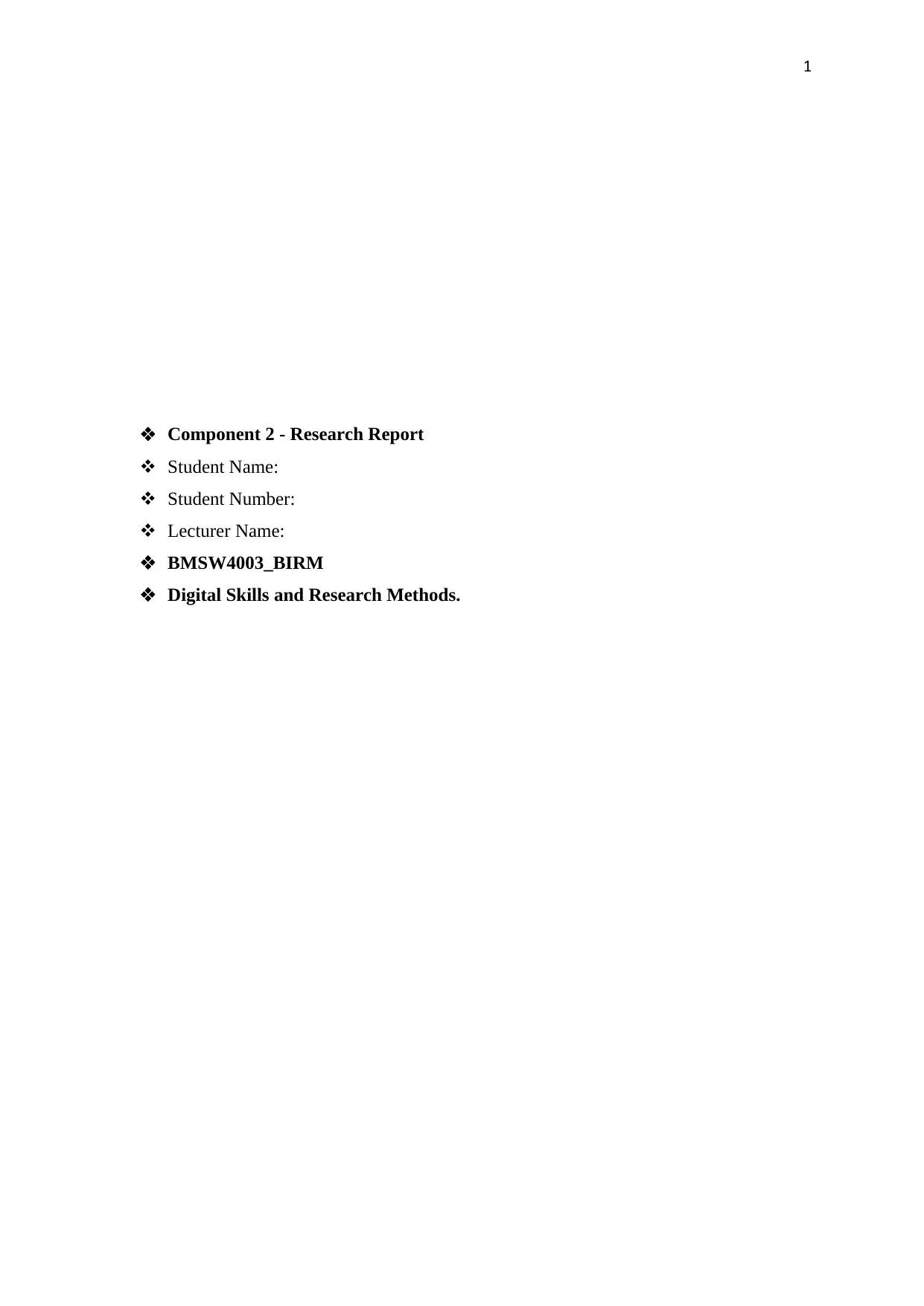
1
Component 2 - Research Report
Student Name:
Student Number:
Lecturer Name:
BMSW4003_BIRM
Digital Skills and Research Methods.
Component 2 - Research Report
Student Name:
Student Number:
Lecturer Name:
BMSW4003_BIRM
Digital Skills and Research Methods.
Paraphrase This Document
Need a fresh take? Get an instant paraphrase of this document with our AI Paraphraser

2
Abstract
Abstract
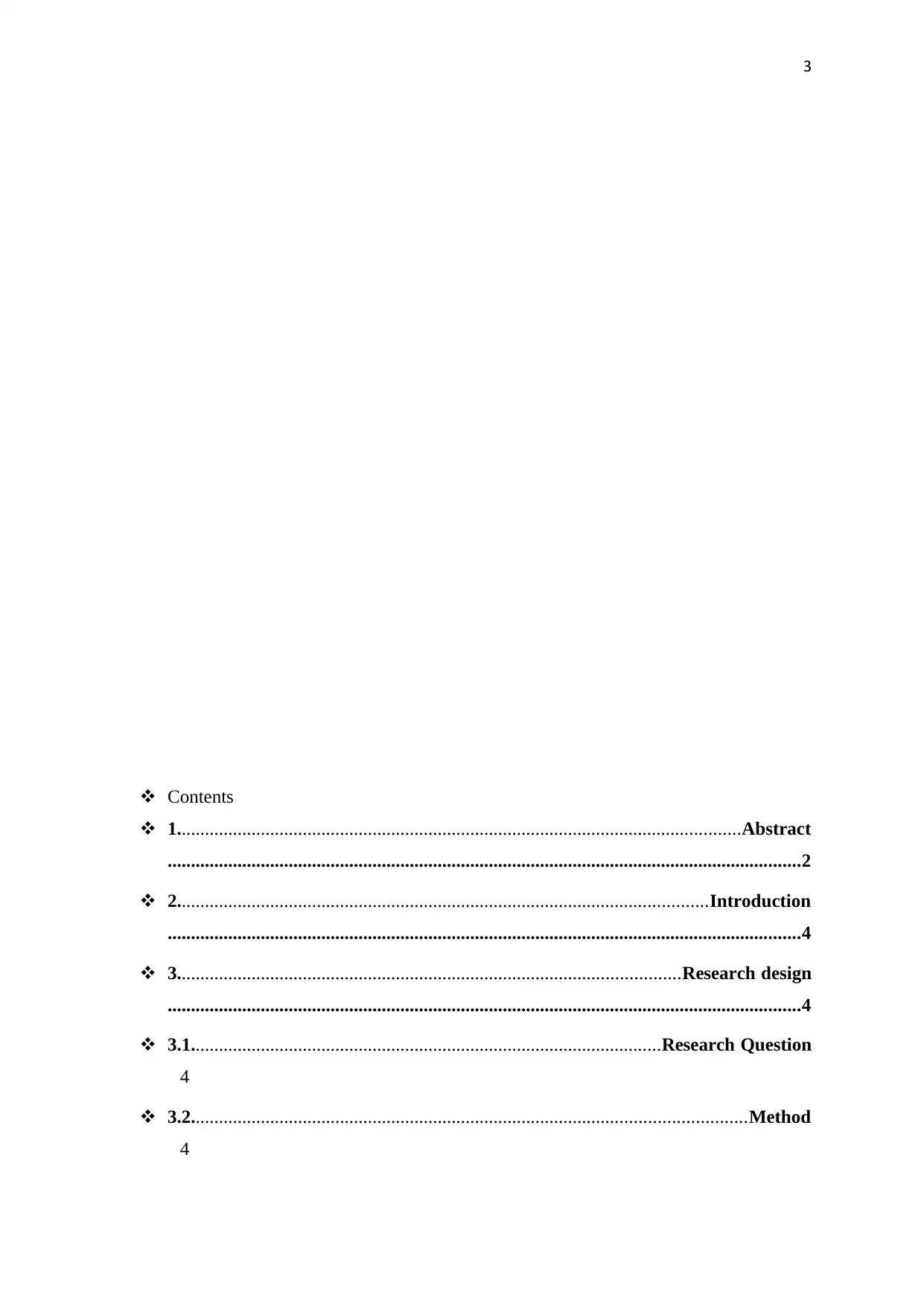
3
Contents
1.........................................................................................................................Abstract
........................................................................................................................................2
2..................................................................................................................Introduction
........................................................................................................................................4
3............................................................................................................Research design
........................................................................................................................................4
3.1.....................................................................................................Research Question
4
3.2.......................................................................................................................Method
4
Contents
1.........................................................................................................................Abstract
........................................................................................................................................2
2..................................................................................................................Introduction
........................................................................................................................................4
3............................................................................................................Research design
........................................................................................................................................4
3.1.....................................................................................................Research Question
4
3.2.......................................................................................................................Method
4
⊘ This is a preview!⊘
Do you want full access?
Subscribe today to unlock all pages.

Trusted by 1+ million students worldwide
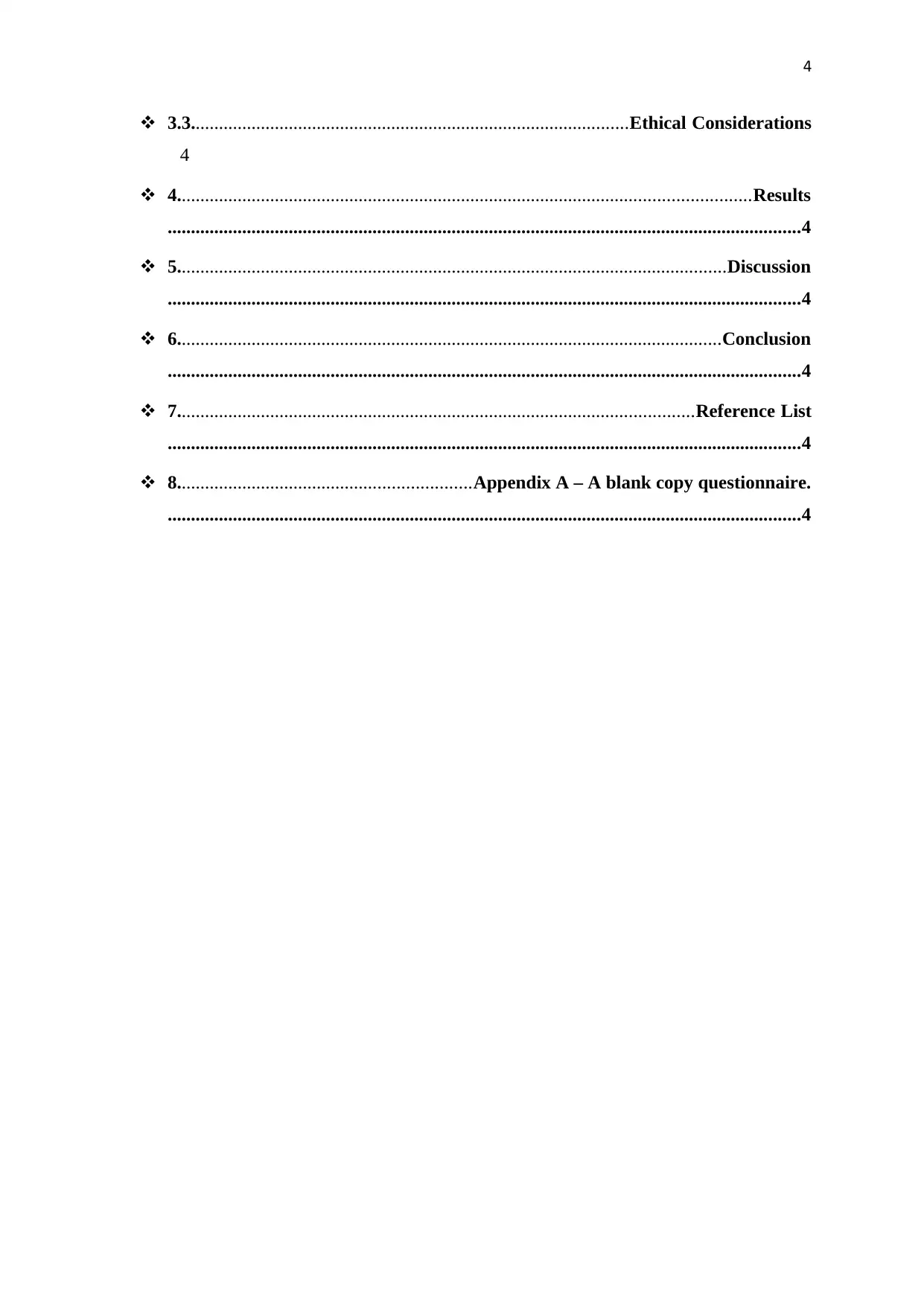
4
3.3..............................................................................................Ethical Considerations
4
4...........................................................................................................................Results
........................................................................................................................................4
5......................................................................................................................Discussion
........................................................................................................................................4
6.....................................................................................................................Conclusion
........................................................................................................................................4
7...............................................................................................................Reference List
........................................................................................................................................4
8...............................................................Appendix A – A blank copy questionnaire.
........................................................................................................................................4
3.3..............................................................................................Ethical Considerations
4
4...........................................................................................................................Results
........................................................................................................................................4
5......................................................................................................................Discussion
........................................................................................................................................4
6.....................................................................................................................Conclusion
........................................................................................................................................4
7...............................................................................................................Reference List
........................................................................................................................................4
8...............................................................Appendix A – A blank copy questionnaire.
........................................................................................................................................4
Paraphrase This Document
Need a fresh take? Get an instant paraphrase of this document with our AI Paraphraser
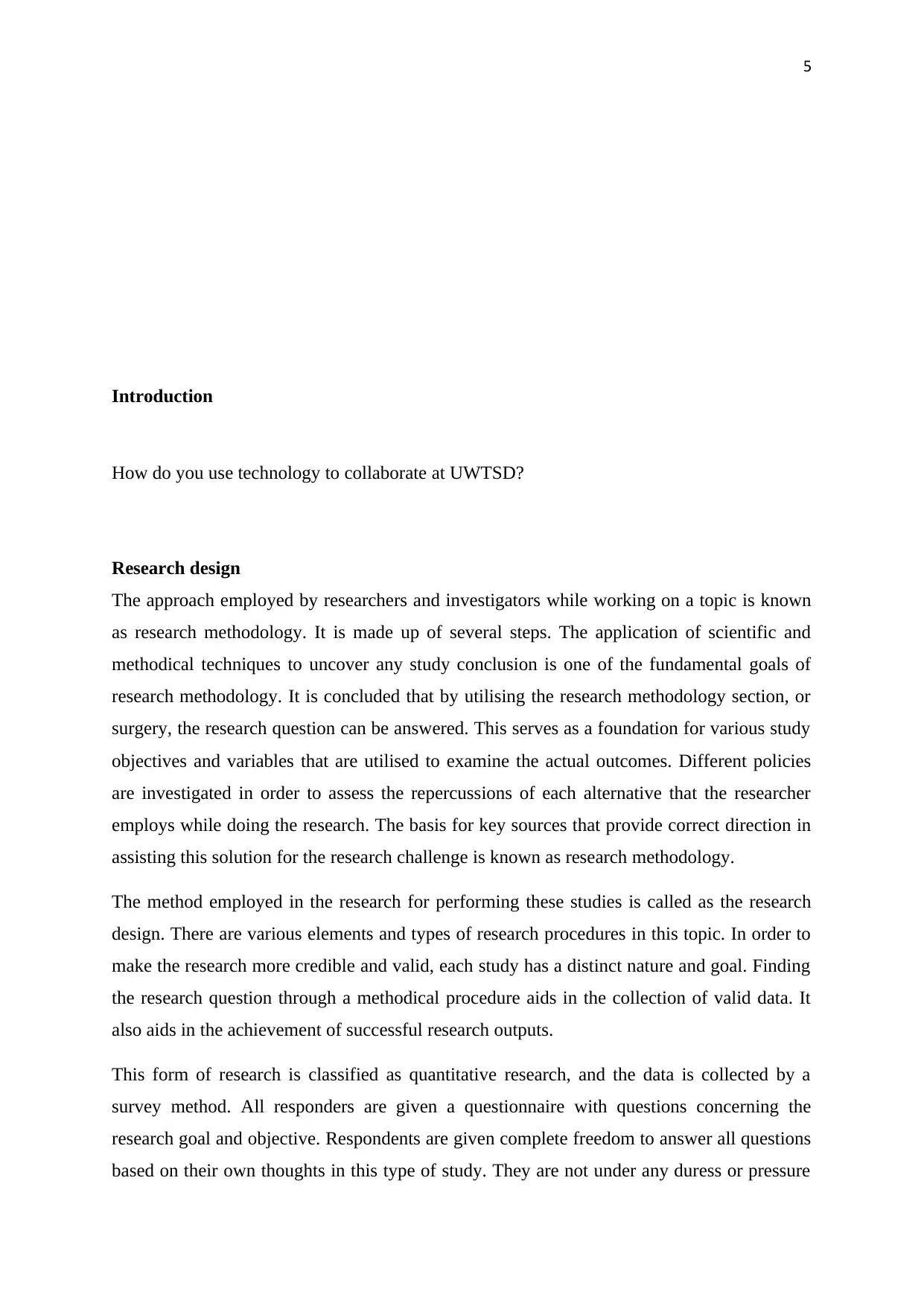
5
Introduction
How do you use technology to collaborate at UWTSD?
Research design
The approach employed by researchers and investigators while working on a topic is known
as research methodology. It is made up of several steps. The application of scientific and
methodical techniques to uncover any study conclusion is one of the fundamental goals of
research methodology. It is concluded that by utilising the research methodology section, or
surgery, the research question can be answered. This serves as a foundation for various study
objectives and variables that are utilised to examine the actual outcomes. Different policies
are investigated in order to assess the repercussions of each alternative that the researcher
employs while doing the research. The basis for key sources that provide correct direction in
assisting this solution for the research challenge is known as research methodology.
The method employed in the research for performing these studies is called as the research
design. There are various elements and types of research procedures in this topic. In order to
make the research more credible and valid, each study has a distinct nature and goal. Finding
the research question through a methodical procedure aids in the collection of valid data. It
also aids in the achievement of successful research outputs.
This form of research is classified as quantitative research, and the data is collected by a
survey method. All responders are given a questionnaire with questions concerning the
research goal and objective. Respondents are given complete freedom to answer all questions
based on their own thoughts in this type of study. They are not under any duress or pressure
Introduction
How do you use technology to collaborate at UWTSD?
Research design
The approach employed by researchers and investigators while working on a topic is known
as research methodology. It is made up of several steps. The application of scientific and
methodical techniques to uncover any study conclusion is one of the fundamental goals of
research methodology. It is concluded that by utilising the research methodology section, or
surgery, the research question can be answered. This serves as a foundation for various study
objectives and variables that are utilised to examine the actual outcomes. Different policies
are investigated in order to assess the repercussions of each alternative that the researcher
employs while doing the research. The basis for key sources that provide correct direction in
assisting this solution for the research challenge is known as research methodology.
The method employed in the research for performing these studies is called as the research
design. There are various elements and types of research procedures in this topic. In order to
make the research more credible and valid, each study has a distinct nature and goal. Finding
the research question through a methodical procedure aids in the collection of valid data. It
also aids in the achievement of successful research outputs.
This form of research is classified as quantitative research, and the data is collected by a
survey method. All responders are given a questionnaire with questions concerning the
research goal and objective. Respondents are given complete freedom to answer all questions
based on their own thoughts in this type of study. They are not under any duress or pressure
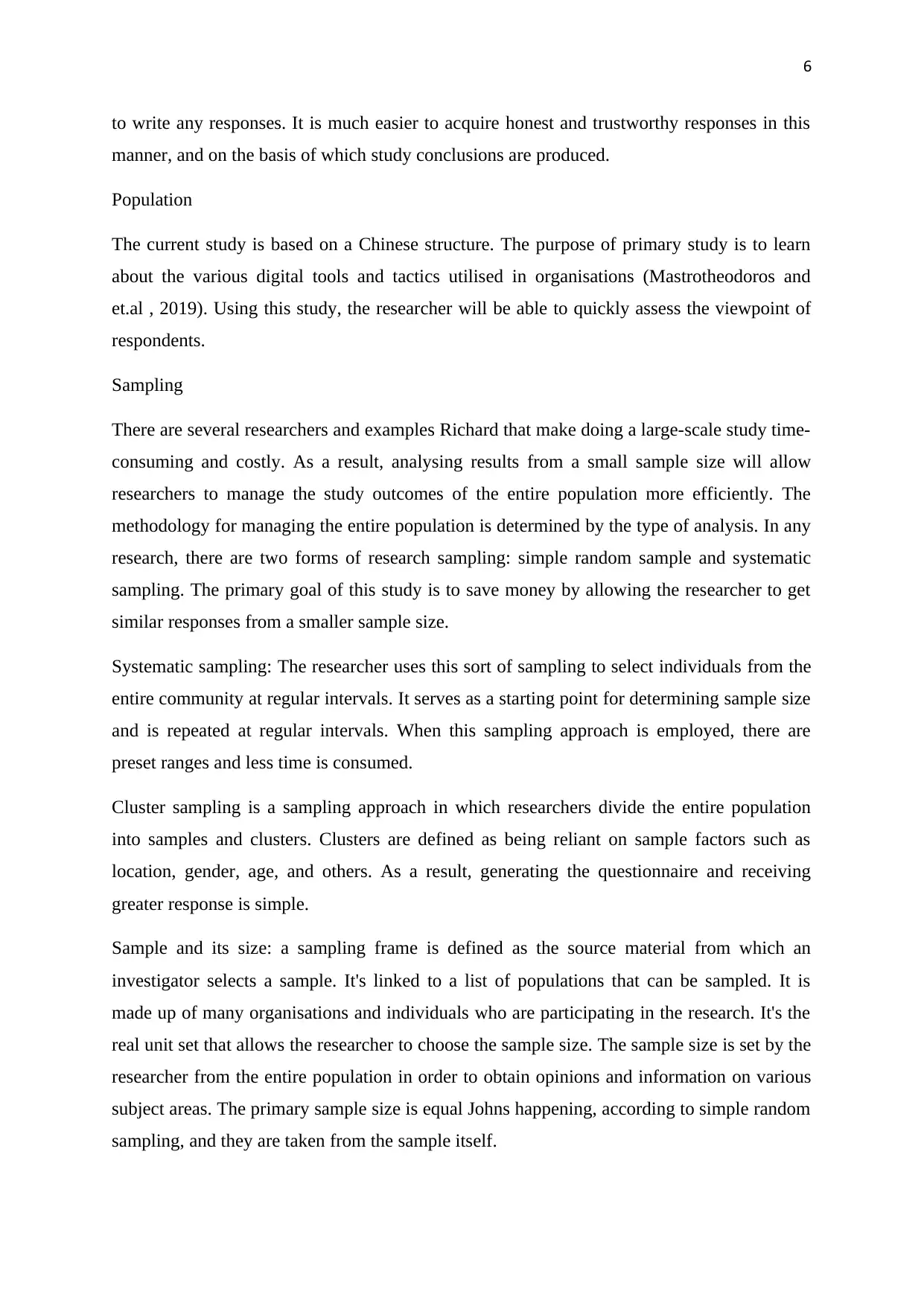
6
to write any responses. It is much easier to acquire honest and trustworthy responses in this
manner, and on the basis of which study conclusions are produced.
Population
The current study is based on a Chinese structure. The purpose of primary study is to learn
about the various digital tools and tactics utilised in organisations (Mastrotheodoros and
et.al , 2019). Using this study, the researcher will be able to quickly assess the viewpoint of
respondents.
Sampling
There are several researchers and examples Richard that make doing a large-scale study time-
consuming and costly. As a result, analysing results from a small sample size will allow
researchers to manage the study outcomes of the entire population more efficiently. The
methodology for managing the entire population is determined by the type of analysis. In any
research, there are two forms of research sampling: simple random sample and systematic
sampling. The primary goal of this study is to save money by allowing the researcher to get
similar responses from a smaller sample size.
Systematic sampling: The researcher uses this sort of sampling to select individuals from the
entire community at regular intervals. It serves as a starting point for determining sample size
and is repeated at regular intervals. When this sampling approach is employed, there are
preset ranges and less time is consumed.
Cluster sampling is a sampling approach in which researchers divide the entire population
into samples and clusters. Clusters are defined as being reliant on sample factors such as
location, gender, age, and others. As a result, generating the questionnaire and receiving
greater response is simple.
Sample and its size: a sampling frame is defined as the source material from which an
investigator selects a sample. It's linked to a list of populations that can be sampled. It is
made up of many organisations and individuals who are participating in the research. It's the
real unit set that allows the researcher to choose the sample size. The sample size is set by the
researcher from the entire population in order to obtain opinions and information on various
subject areas. The primary sample size is equal Johns happening, according to simple random
sampling, and they are taken from the sample itself.
to write any responses. It is much easier to acquire honest and trustworthy responses in this
manner, and on the basis of which study conclusions are produced.
Population
The current study is based on a Chinese structure. The purpose of primary study is to learn
about the various digital tools and tactics utilised in organisations (Mastrotheodoros and
et.al , 2019). Using this study, the researcher will be able to quickly assess the viewpoint of
respondents.
Sampling
There are several researchers and examples Richard that make doing a large-scale study time-
consuming and costly. As a result, analysing results from a small sample size will allow
researchers to manage the study outcomes of the entire population more efficiently. The
methodology for managing the entire population is determined by the type of analysis. In any
research, there are two forms of research sampling: simple random sample and systematic
sampling. The primary goal of this study is to save money by allowing the researcher to get
similar responses from a smaller sample size.
Systematic sampling: The researcher uses this sort of sampling to select individuals from the
entire community at regular intervals. It serves as a starting point for determining sample size
and is repeated at regular intervals. When this sampling approach is employed, there are
preset ranges and less time is consumed.
Cluster sampling is a sampling approach in which researchers divide the entire population
into samples and clusters. Clusters are defined as being reliant on sample factors such as
location, gender, age, and others. As a result, generating the questionnaire and receiving
greater response is simple.
Sample and its size: a sampling frame is defined as the source material from which an
investigator selects a sample. It's linked to a list of populations that can be sampled. It is
made up of many organisations and individuals who are participating in the research. It's the
real unit set that allows the researcher to choose the sample size. The sample size is set by the
researcher from the entire population in order to obtain opinions and information on various
subject areas. The primary sample size is equal Johns happening, according to simple random
sampling, and they are taken from the sample itself.
⊘ This is a preview!⊘
Do you want full access?
Subscribe today to unlock all pages.

Trusted by 1+ million students worldwide
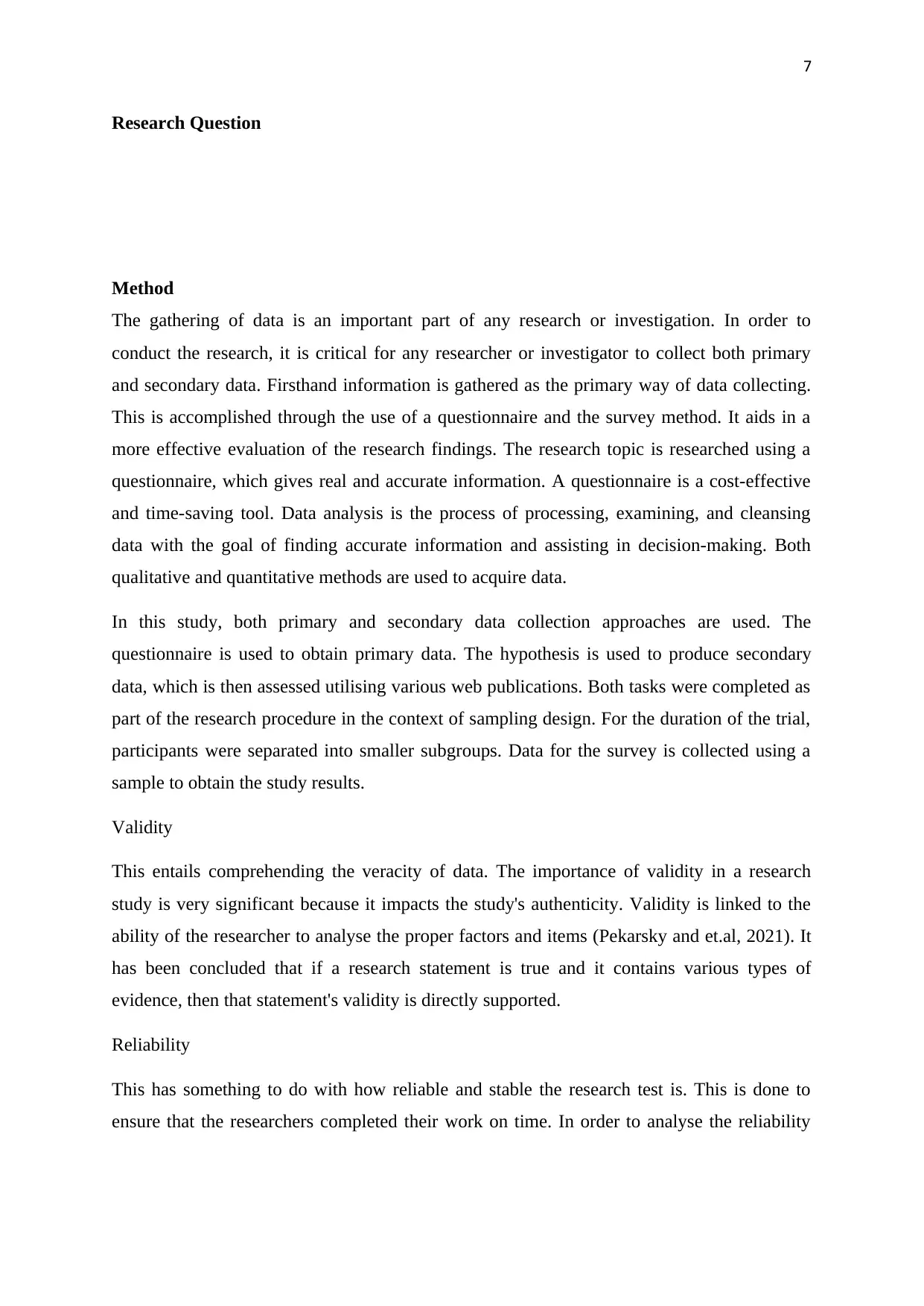
7
Research Question
Method
The gathering of data is an important part of any research or investigation. In order to
conduct the research, it is critical for any researcher or investigator to collect both primary
and secondary data. Firsthand information is gathered as the primary way of data collecting.
This is accomplished through the use of a questionnaire and the survey method. It aids in a
more effective evaluation of the research findings. The research topic is researched using a
questionnaire, which gives real and accurate information. A questionnaire is a cost-effective
and time-saving tool. Data analysis is the process of processing, examining, and cleansing
data with the goal of finding accurate information and assisting in decision-making. Both
qualitative and quantitative methods are used to acquire data.
In this study, both primary and secondary data collection approaches are used. The
questionnaire is used to obtain primary data. The hypothesis is used to produce secondary
data, which is then assessed utilising various web publications. Both tasks were completed as
part of the research procedure in the context of sampling design. For the duration of the trial,
participants were separated into smaller subgroups. Data for the survey is collected using a
sample to obtain the study results.
Validity
This entails comprehending the veracity of data. The importance of validity in a research
study is very significant because it impacts the study's authenticity. Validity is linked to the
ability of the researcher to analyse the proper factors and items (Pekarsky and et.al, 2021). It
has been concluded that if a research statement is true and it contains various types of
evidence, then that statement's validity is directly supported.
Reliability
This has something to do with how reliable and stable the research test is. This is done to
ensure that the researchers completed their work on time. In order to analyse the reliability
Research Question
Method
The gathering of data is an important part of any research or investigation. In order to
conduct the research, it is critical for any researcher or investigator to collect both primary
and secondary data. Firsthand information is gathered as the primary way of data collecting.
This is accomplished through the use of a questionnaire and the survey method. It aids in a
more effective evaluation of the research findings. The research topic is researched using a
questionnaire, which gives real and accurate information. A questionnaire is a cost-effective
and time-saving tool. Data analysis is the process of processing, examining, and cleansing
data with the goal of finding accurate information and assisting in decision-making. Both
qualitative and quantitative methods are used to acquire data.
In this study, both primary and secondary data collection approaches are used. The
questionnaire is used to obtain primary data. The hypothesis is used to produce secondary
data, which is then assessed utilising various web publications. Both tasks were completed as
part of the research procedure in the context of sampling design. For the duration of the trial,
participants were separated into smaller subgroups. Data for the survey is collected using a
sample to obtain the study results.
Validity
This entails comprehending the veracity of data. The importance of validity in a research
study is very significant because it impacts the study's authenticity. Validity is linked to the
ability of the researcher to analyse the proper factors and items (Pekarsky and et.al, 2021). It
has been concluded that if a research statement is true and it contains various types of
evidence, then that statement's validity is directly supported.
Reliability
This has something to do with how reliable and stable the research test is. This is done to
ensure that the researchers completed their work on time. In order to analyse the reliability
Paraphrase This Document
Need a fresh take? Get an instant paraphrase of this document with our AI Paraphraser
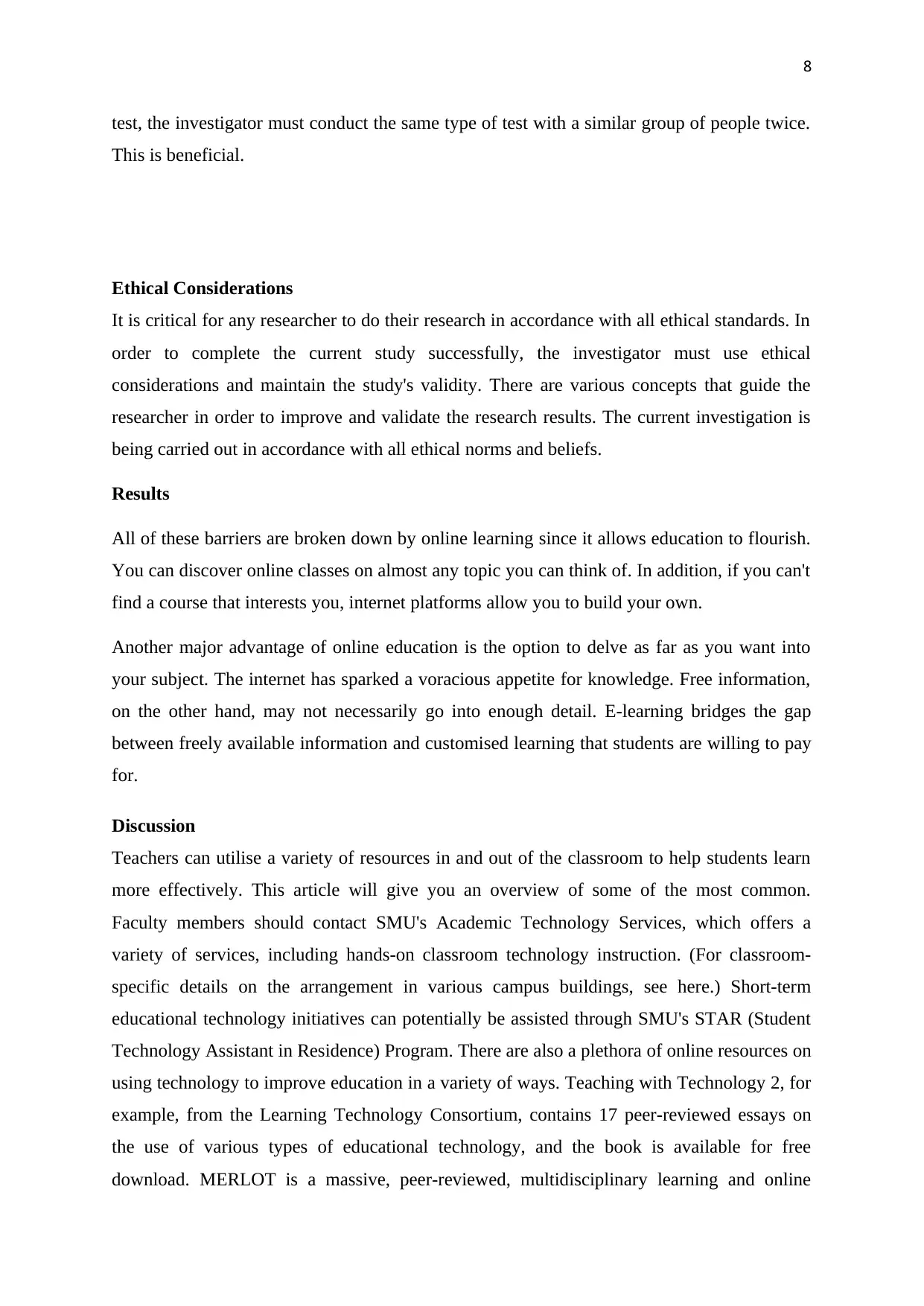
8
test, the investigator must conduct the same type of test with a similar group of people twice.
This is beneficial.
Ethical Considerations
It is critical for any researcher to do their research in accordance with all ethical standards. In
order to complete the current study successfully, the investigator must use ethical
considerations and maintain the study's validity. There are various concepts that guide the
researcher in order to improve and validate the research results. The current investigation is
being carried out in accordance with all ethical norms and beliefs.
Results
All of these barriers are broken down by online learning since it allows education to flourish.
You can discover online classes on almost any topic you can think of. In addition, if you can't
find a course that interests you, internet platforms allow you to build your own.
Another major advantage of online education is the option to delve as far as you want into
your subject. The internet has sparked a voracious appetite for knowledge. Free information,
on the other hand, may not necessarily go into enough detail. E-learning bridges the gap
between freely available information and customised learning that students are willing to pay
for.
Discussion
Teachers can utilise a variety of resources in and out of the classroom to help students learn
more effectively. This article will give you an overview of some of the most common.
Faculty members should contact SMU's Academic Technology Services, which offers a
variety of services, including hands-on classroom technology instruction. (For classroom-
specific details on the arrangement in various campus buildings, see here.) Short-term
educational technology initiatives can potentially be assisted through SMU's STAR (Student
Technology Assistant in Residence) Program. There are also a plethora of online resources on
using technology to improve education in a variety of ways. Teaching with Technology 2, for
example, from the Learning Technology Consortium, contains 17 peer-reviewed essays on
the use of various types of educational technology, and the book is available for free
download. MERLOT is a massive, peer-reviewed, multidisciplinary learning and online
test, the investigator must conduct the same type of test with a similar group of people twice.
This is beneficial.
Ethical Considerations
It is critical for any researcher to do their research in accordance with all ethical standards. In
order to complete the current study successfully, the investigator must use ethical
considerations and maintain the study's validity. There are various concepts that guide the
researcher in order to improve and validate the research results. The current investigation is
being carried out in accordance with all ethical norms and beliefs.
Results
All of these barriers are broken down by online learning since it allows education to flourish.
You can discover online classes on almost any topic you can think of. In addition, if you can't
find a course that interests you, internet platforms allow you to build your own.
Another major advantage of online education is the option to delve as far as you want into
your subject. The internet has sparked a voracious appetite for knowledge. Free information,
on the other hand, may not necessarily go into enough detail. E-learning bridges the gap
between freely available information and customised learning that students are willing to pay
for.
Discussion
Teachers can utilise a variety of resources in and out of the classroom to help students learn
more effectively. This article will give you an overview of some of the most common.
Faculty members should contact SMU's Academic Technology Services, which offers a
variety of services, including hands-on classroom technology instruction. (For classroom-
specific details on the arrangement in various campus buildings, see here.) Short-term
educational technology initiatives can potentially be assisted through SMU's STAR (Student
Technology Assistant in Residence) Program. There are also a plethora of online resources on
using technology to improve education in a variety of ways. Teaching with Technology 2, for
example, from the Learning Technology Consortium, contains 17 peer-reviewed essays on
the use of various types of educational technology, and the book is available for free
download. MERLOT is a massive, peer-reviewed, multidisciplinary learning and online
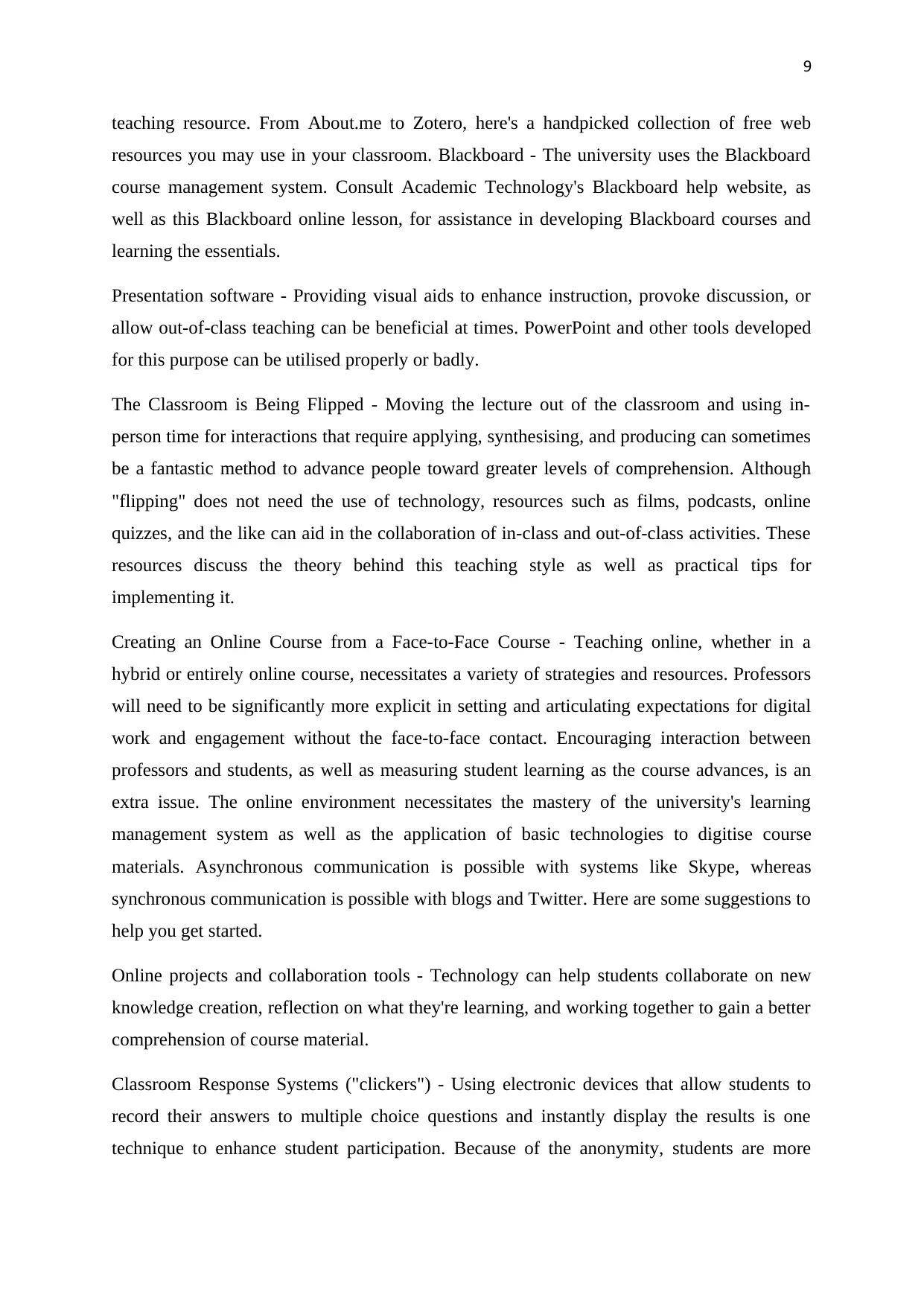
9
teaching resource. From About.me to Zotero, here's a handpicked collection of free web
resources you may use in your classroom. Blackboard - The university uses the Blackboard
course management system. Consult Academic Technology's Blackboard help website, as
well as this Blackboard online lesson, for assistance in developing Blackboard courses and
learning the essentials.
Presentation software - Providing visual aids to enhance instruction, provoke discussion, or
allow out-of-class teaching can be beneficial at times. PowerPoint and other tools developed
for this purpose can be utilised properly or badly.
The Classroom is Being Flipped - Moving the lecture out of the classroom and using in-
person time for interactions that require applying, synthesising, and producing can sometimes
be a fantastic method to advance people toward greater levels of comprehension. Although
"flipping" does not need the use of technology, resources such as films, podcasts, online
quizzes, and the like can aid in the collaboration of in-class and out-of-class activities. These
resources discuss the theory behind this teaching style as well as practical tips for
implementing it.
Creating an Online Course from a Face-to-Face Course - Teaching online, whether in a
hybrid or entirely online course, necessitates a variety of strategies and resources. Professors
will need to be significantly more explicit in setting and articulating expectations for digital
work and engagement without the face-to-face contact. Encouraging interaction between
professors and students, as well as measuring student learning as the course advances, is an
extra issue. The online environment necessitates the mastery of the university's learning
management system as well as the application of basic technologies to digitise course
materials. Asynchronous communication is possible with systems like Skype, whereas
synchronous communication is possible with blogs and Twitter. Here are some suggestions to
help you get started.
Online projects and collaboration tools - Technology can help students collaborate on new
knowledge creation, reflection on what they're learning, and working together to gain a better
comprehension of course material.
Classroom Response Systems ("clickers") - Using electronic devices that allow students to
record their answers to multiple choice questions and instantly display the results is one
technique to enhance student participation. Because of the anonymity, students are more
teaching resource. From About.me to Zotero, here's a handpicked collection of free web
resources you may use in your classroom. Blackboard - The university uses the Blackboard
course management system. Consult Academic Technology's Blackboard help website, as
well as this Blackboard online lesson, for assistance in developing Blackboard courses and
learning the essentials.
Presentation software - Providing visual aids to enhance instruction, provoke discussion, or
allow out-of-class teaching can be beneficial at times. PowerPoint and other tools developed
for this purpose can be utilised properly or badly.
The Classroom is Being Flipped - Moving the lecture out of the classroom and using in-
person time for interactions that require applying, synthesising, and producing can sometimes
be a fantastic method to advance people toward greater levels of comprehension. Although
"flipping" does not need the use of technology, resources such as films, podcasts, online
quizzes, and the like can aid in the collaboration of in-class and out-of-class activities. These
resources discuss the theory behind this teaching style as well as practical tips for
implementing it.
Creating an Online Course from a Face-to-Face Course - Teaching online, whether in a
hybrid or entirely online course, necessitates a variety of strategies and resources. Professors
will need to be significantly more explicit in setting and articulating expectations for digital
work and engagement without the face-to-face contact. Encouraging interaction between
professors and students, as well as measuring student learning as the course advances, is an
extra issue. The online environment necessitates the mastery of the university's learning
management system as well as the application of basic technologies to digitise course
materials. Asynchronous communication is possible with systems like Skype, whereas
synchronous communication is possible with blogs and Twitter. Here are some suggestions to
help you get started.
Online projects and collaboration tools - Technology can help students collaborate on new
knowledge creation, reflection on what they're learning, and working together to gain a better
comprehension of course material.
Classroom Response Systems ("clickers") - Using electronic devices that allow students to
record their answers to multiple choice questions and instantly display the results is one
technique to enhance student participation. Because of the anonymity, students are more
⊘ This is a preview!⊘
Do you want full access?
Subscribe today to unlock all pages.

Trusted by 1+ million students worldwide
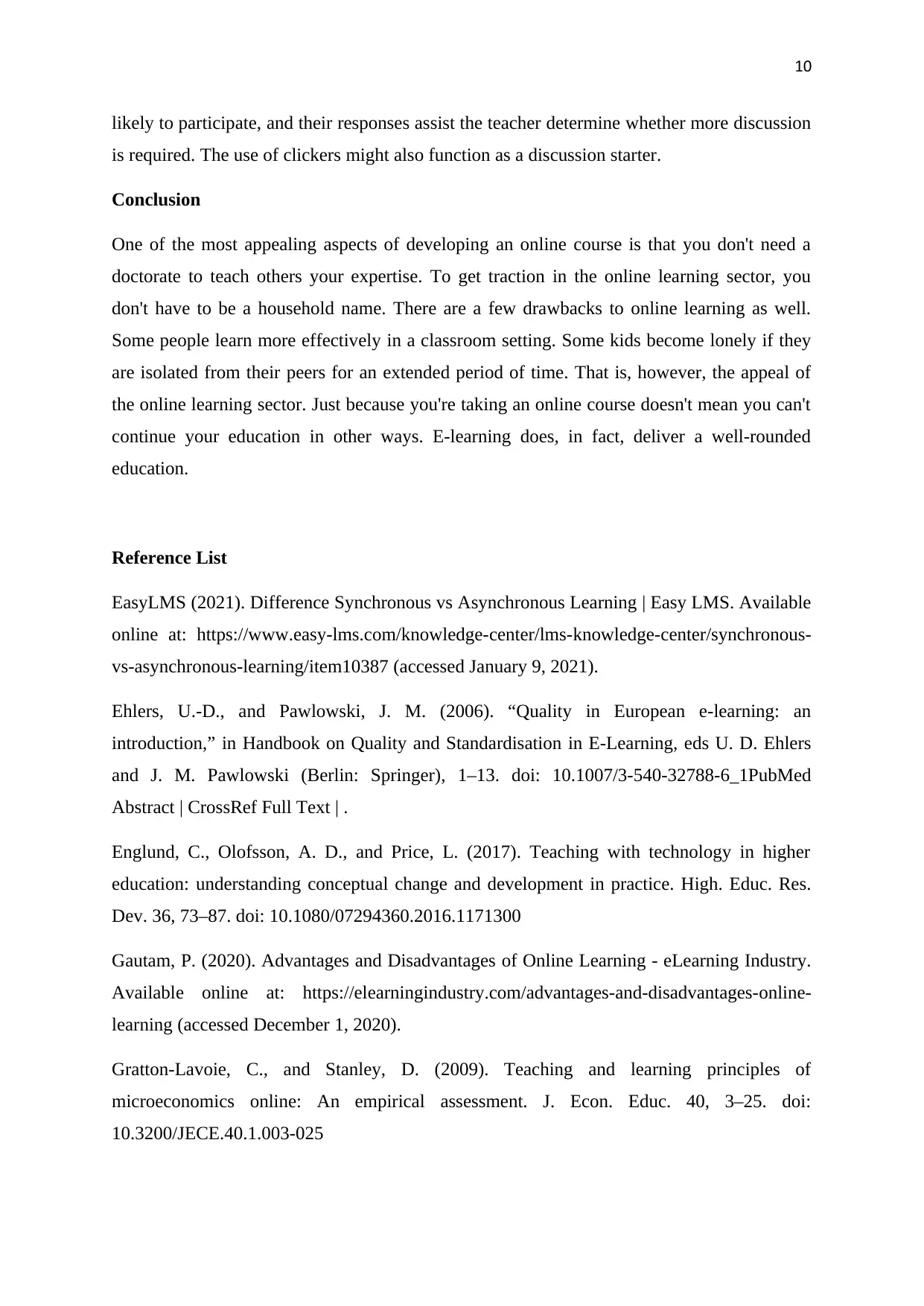
10
likely to participate, and their responses assist the teacher determine whether more discussion
is required. The use of clickers might also function as a discussion starter.
Conclusion
One of the most appealing aspects of developing an online course is that you don't need a
doctorate to teach others your expertise. To get traction in the online learning sector, you
don't have to be a household name. There are a few drawbacks to online learning as well.
Some people learn more effectively in a classroom setting. Some kids become lonely if they
are isolated from their peers for an extended period of time. That is, however, the appeal of
the online learning sector. Just because you're taking an online course doesn't mean you can't
continue your education in other ways. E-learning does, in fact, deliver a well-rounded
education.
Reference List
EasyLMS (2021). Difference Synchronous vs Asynchronous Learning | Easy LMS. Available
online at: https://www.easy-lms.com/knowledge-center/lms-knowledge-center/synchronous-
vs-asynchronous-learning/item10387 (accessed January 9, 2021).
Ehlers, U.-D., and Pawlowski, J. M. (2006). “Quality in European e-learning: an
introduction,” in Handbook on Quality and Standardisation in E-Learning, eds U. D. Ehlers
and J. M. Pawlowski (Berlin: Springer), 1–13. doi: 10.1007/3-540-32788-6_1PubMed
Abstract | CrossRef Full Text | .
Englund, C., Olofsson, A. D., and Price, L. (2017). Teaching with technology in higher
education: understanding conceptual change and development in practice. High. Educ. Res.
Dev. 36, 73–87. doi: 10.1080/07294360.2016.1171300
Gautam, P. (2020). Advantages and Disadvantages of Online Learning - eLearning Industry.
Available online at: https://elearningindustry.com/advantages-and-disadvantages-online-
learning (accessed December 1, 2020).
Gratton-Lavoie, C., and Stanley, D. (2009). Teaching and learning principles of
microeconomics online: An empirical assessment. J. Econ. Educ. 40, 3–25. doi:
10.3200/JECE.40.1.003-025
likely to participate, and their responses assist the teacher determine whether more discussion
is required. The use of clickers might also function as a discussion starter.
Conclusion
One of the most appealing aspects of developing an online course is that you don't need a
doctorate to teach others your expertise. To get traction in the online learning sector, you
don't have to be a household name. There are a few drawbacks to online learning as well.
Some people learn more effectively in a classroom setting. Some kids become lonely if they
are isolated from their peers for an extended period of time. That is, however, the appeal of
the online learning sector. Just because you're taking an online course doesn't mean you can't
continue your education in other ways. E-learning does, in fact, deliver a well-rounded
education.
Reference List
EasyLMS (2021). Difference Synchronous vs Asynchronous Learning | Easy LMS. Available
online at: https://www.easy-lms.com/knowledge-center/lms-knowledge-center/synchronous-
vs-asynchronous-learning/item10387 (accessed January 9, 2021).
Ehlers, U.-D., and Pawlowski, J. M. (2006). “Quality in European e-learning: an
introduction,” in Handbook on Quality and Standardisation in E-Learning, eds U. D. Ehlers
and J. M. Pawlowski (Berlin: Springer), 1–13. doi: 10.1007/3-540-32788-6_1PubMed
Abstract | CrossRef Full Text | .
Englund, C., Olofsson, A. D., and Price, L. (2017). Teaching with technology in higher
education: understanding conceptual change and development in practice. High. Educ. Res.
Dev. 36, 73–87. doi: 10.1080/07294360.2016.1171300
Gautam, P. (2020). Advantages and Disadvantages of Online Learning - eLearning Industry.
Available online at: https://elearningindustry.com/advantages-and-disadvantages-online-
learning (accessed December 1, 2020).
Gratton-Lavoie, C., and Stanley, D. (2009). Teaching and learning principles of
microeconomics online: An empirical assessment. J. Econ. Educ. 40, 3–25. doi:
10.3200/JECE.40.1.003-025
Paraphrase This Document
Need a fresh take? Get an instant paraphrase of this document with our AI Paraphraser

11
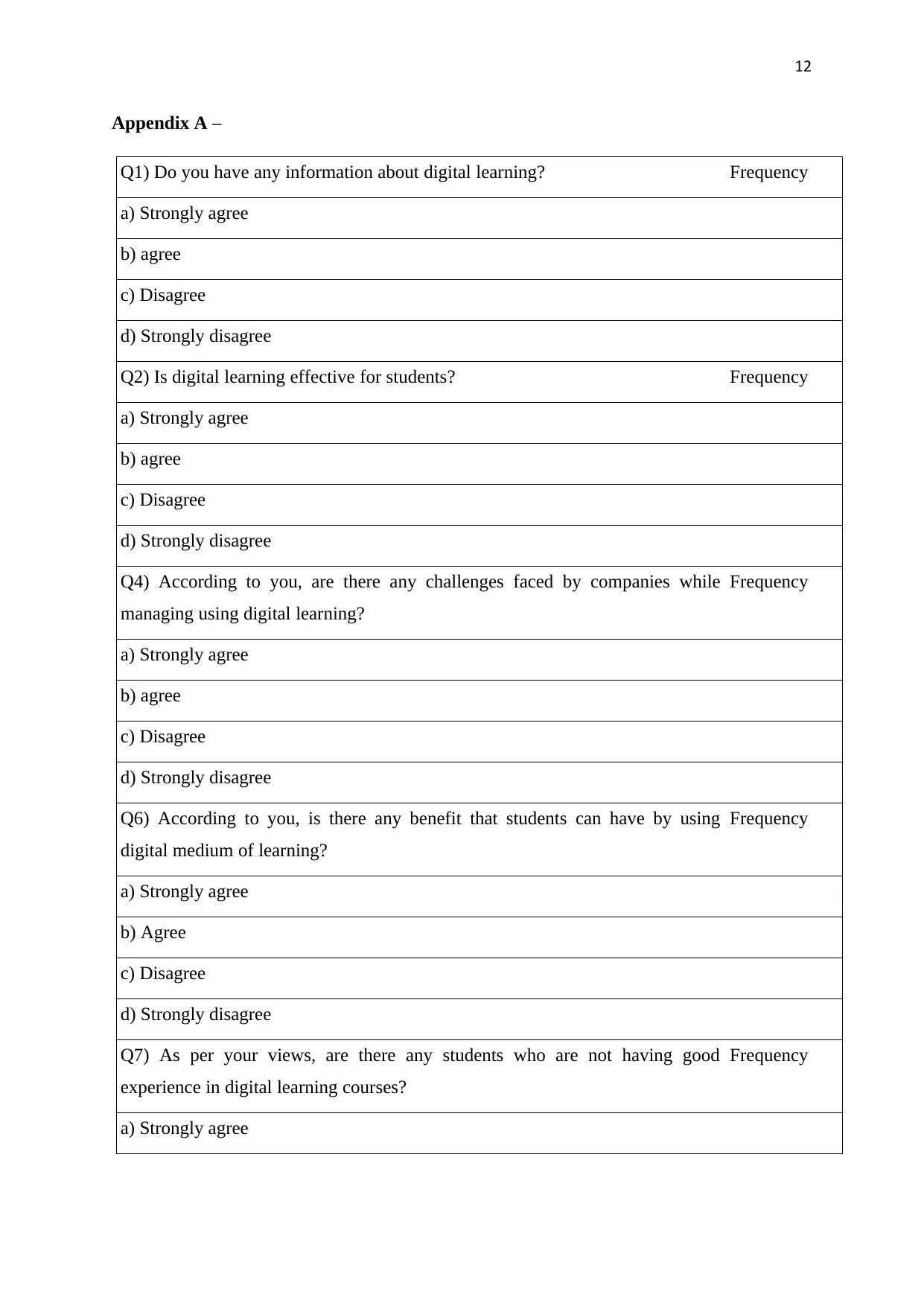
12
Appendix A –
Q1) Do you have any information about digital learning? Frequency
a) Strongly agree
b) agree
c) Disagree
d) Strongly disagree
Q2) Is digital learning effective for students? Frequency
a) Strongly agree
b) agree
c) Disagree
d) Strongly disagree
Q4) According to you, are there any challenges faced by companies while
managing using digital learning?
Frequency
a) Strongly agree
b) agree
c) Disagree
d) Strongly disagree
Q6) According to you, is there any benefit that students can have by using
digital medium of learning?
Frequency
a) Strongly agree
b) Agree
c) Disagree
d) Strongly disagree
Q7) As per your views, are there any students who are not having good
experience in digital learning courses?
Frequency
a) Strongly agree
Appendix A –
Q1) Do you have any information about digital learning? Frequency
a) Strongly agree
b) agree
c) Disagree
d) Strongly disagree
Q2) Is digital learning effective for students? Frequency
a) Strongly agree
b) agree
c) Disagree
d) Strongly disagree
Q4) According to you, are there any challenges faced by companies while
managing using digital learning?
Frequency
a) Strongly agree
b) agree
c) Disagree
d) Strongly disagree
Q6) According to you, is there any benefit that students can have by using
digital medium of learning?
Frequency
a) Strongly agree
b) Agree
c) Disagree
d) Strongly disagree
Q7) As per your views, are there any students who are not having good
experience in digital learning courses?
Frequency
a) Strongly agree
⊘ This is a preview!⊘
Do you want full access?
Subscribe today to unlock all pages.

Trusted by 1+ million students worldwide
1 out of 13
Related Documents
Your All-in-One AI-Powered Toolkit for Academic Success.
+13062052269
info@desklib.com
Available 24*7 on WhatsApp / Email
![[object Object]](/_next/static/media/star-bottom.7253800d.svg)
Unlock your academic potential
Copyright © 2020–2025 A2Z Services. All Rights Reserved. Developed and managed by ZUCOL.





